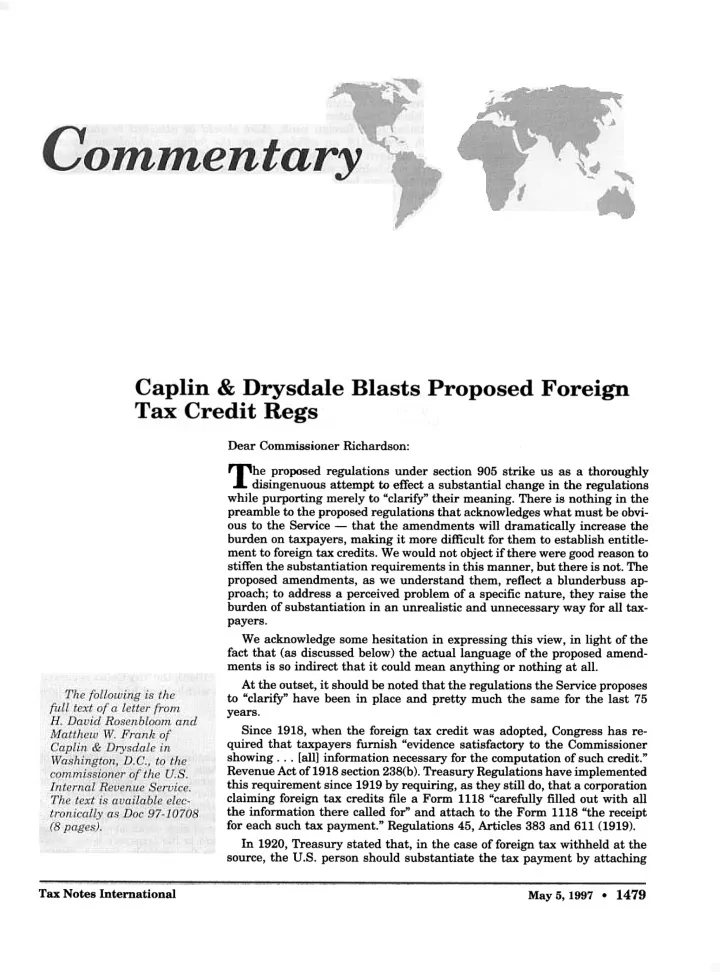

Dear Commissioner Richardson: T he proposed regulations under section 905 strike us as a thoroughly disingenuous attempt to effect a substantial change in the regulations whjle purporting merely to "clarify" their meaning. There is nothing in the preamble to the proposed regulations that acknowledges what must be obvi- ous to the Service -that the amendments will dramatically increase the burden on taxpayers, making it more difficult for them to establish entitle- ment to foreign tax credits. We would not object if there were good reason to stiffen the substantiation requirements in this manner, but there is not. The proposed amendments, as we understand them, reflect a blunderbuss ap- proach; to address a perceived problem of a specific nature, they raise the burden of substantiation in an unrealistic and unnecessary way for all tax- payers. We acknowledge some hesitation in expressing this view, in light of the fact that (as discussed below) the actual language of the proposed amend- ments is so indirect that it could mean anything or nothing at all. At the outset, it should be noted that the regulations the Service proposes to "clarify" have been in place and pretty much the same for the last 75 years. Since 1918, when the foreign tax credit was adopted, Congress has re- quired that taxpayers furnish "evidence satisfactory to the Commissioner showing. ..[all] information necessary for the computation of such credit." Revenue Act of 1918 section 238(b). Treasury Regulations have implemented this requirement since 1919 by requiring, as they still do, that a corporation claiming foreign tax credits file a Form 1118 "carefully filled out with all the information there called for" and attach to the Form 1118 "the receipt for each such tax payment." Regulations 45, Articles 383 and 611 (1919). In 1920, Treasury stated that, in the case of foreign tax withheld at the source, the U .S. person should substantiate the tax payment by attaching Tax Notes International May 5, 1997 .1479
Commentary to the Form 1118 an affidavit from the withholding agent confirming the amount of tax withheld and paid. Treasury stated: When credit is claimed by an American bank for the amount of tax withheld from interest on bank deposits and paid to a foreign Gov- ernment by a foreign bank, there should be attached to and filed with form 1118, an affidavit from the foreign withholding agent. The affidavit should set forth the title of the statute under which such withholding was required, the amount of interest accrued to the American bank, and the amount of tax withheld and paid to the foreign Government. O.D. 671, 3 C.B. 283 (1920). In 1933, Treasury reaffirmed that an affidavit from a foreign withholding agent would be treated as a "r~ceipt of payment" and would satisfy the substantiation requirements for claiming a foreign tax credit where the taxpayer could not otherwise obtain a receipt from the foreign government. The actual language Treasury stated: of the proposed In general, by "receipt" is meant a receipt issued by a foreign gov- amendments is ernment to one of its taxpayers for taxes paid on the latter's own so indirect that it income or upon income of a distributee where such taxpayer is the could mean any- distributor. However, in the case of taxes paid at the source upon thing or nothing dividends, interest, or royalties distributed to a domestic share- at all. holder or creditor. ..A certified statement by the foreign distribu- tor. ..showing the gross distribution, the tax withheld, and the net amount credited to the domestic taxpayer, may be considered a re- ceipt for the purpose of credit allowances, provided that in these cases of taxes withheld at a foreign source the domestic taxpayer is unable to secure receipts issued by the foreign government, and provided further that such credits shall be subject to the usual veri- fication of income and application of known foreign tax rates thereto. I.T. 2676, XII-I C.B. 48,49 (1933). Eight years later, Treasury amended the regulations to make the sub- stantiation requirements for foreign tax credits "more flexible" by authoriz- ing the receipt of secondary evidence "in support of credit for foreign taxes." I.R. Mim. 5219, 1941-2 C.B. 140. The 1920 and 1933 Treasury decisions had already established that "an affidavit" or "a certified statement" from a foreign withholding agent was acceptable proof of payment, so the 1941 amendments built upon this premise and provided that where a taxpayer could not "furnish { 1) a receipt for such foreign tax payment or (2) the foreign tax return or (3) direct evidence of the amount of tax withheld at the source," then the Commissioner could, in his discretion, accept secondary evidence "of the payment or accrual of the tax or of the withholding of the tax. ..." T.D. 5056,1941-2 C.B. 139.1 In Lederman v. Commissioner, 6 T.C. 991 (1946), the Tax Court reviewed the regulations and stated: "it is clear that withholding and payment are lThe explanation accompanying the 1941 amendments illustrated the type of secondary evidence envisioned. These illustrations, which were incorporated di- rectly into the regulations in 1957 and now appear as Treasury Regulation section 1.905-2(b)(1), (2), and (3), stated in part that "where evidence of withholding can- not be secured from those who have made the payments [a reference to the type of certified statement identified in the 1933 Treasury decision], the Commissioner may in his discretion accept secondary evidence of such withholding and of the amount of the tax so withheld, having due regard to the taxpayer's books of ac- count and to the rates of taxation prevailing in the particular foreign country during the period involved." I.R. Mim. 5219, 1941-2 C.B. 140. Tax Notes International 1480 .May 5, 1997
Recommend
More recommend